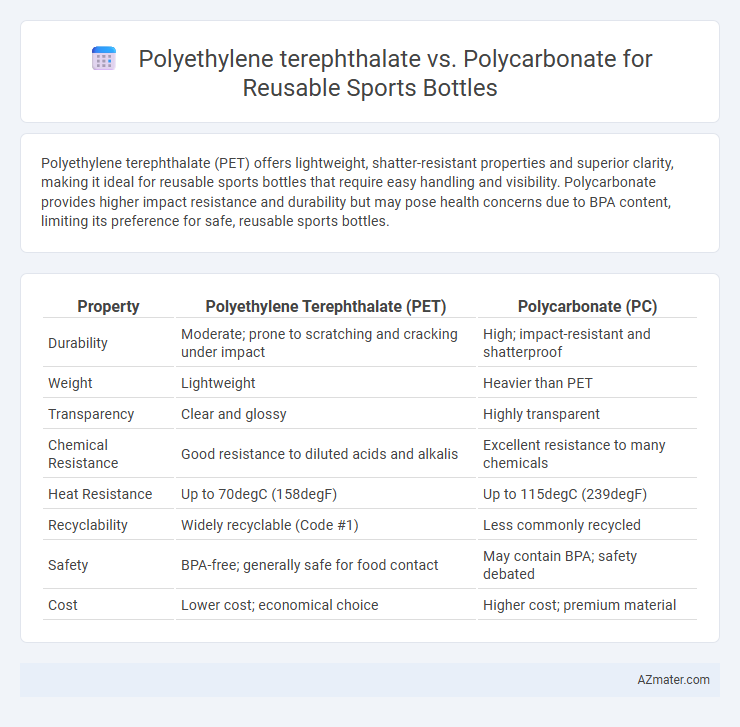Polyethylene terephthalate (PET) offers lightweight, shatter-resistant properties and superior clarity, making it ideal for reusable sports bottles that require easy handling and visibility. Polycarbonate provides higher impact resistance and durability but may pose health concerns due to BPA content, limiting its preference for safe, reusable sports bottles.
Table of Comparison
| Property | Polyethylene Terephthalate (PET) | Polycarbonate (PC) |
|---|---|---|
| Durability | Moderate; prone to scratching and cracking under impact | High; impact-resistant and shatterproof |
| Weight | Lightweight | Heavier than PET |
| Transparency | Clear and glossy | Highly transparent |
| Chemical Resistance | Good resistance to diluted acids and alkalis | Excellent resistance to many chemicals |
| Heat Resistance | Up to 70degC (158degF) | Up to 115degC (239degF) |
| Recyclability | Widely recyclable (Code #1) | Less commonly recycled |
| Safety | BPA-free; generally safe for food contact | May contain BPA; safety debated |
| Cost | Lower cost; economical choice | Higher cost; premium material |
Introduction to Reusable Sports Bottles
Reusable sports bottles made from polyethylene terephthalate (PET) offer lightweight durability and excellent resistance to impact and chemicals, making them ideal for daily hydration. Polycarbonate (PC) bottles provide superior strength, high temperature resistance, and clarity, often favored for their long-term sturdiness and ease of cleaning. Choosing between PET and polycarbonate depends on factors such as expected usage, exposure to heat, and environmental impact, with both materials being widely used in sustainable sports bottle designs.
What is Polyethylene Terephthalate (PET)?
Polyethylene terephthalate (PET) is a lightweight, durable thermoplastic polymer widely used for reusable sports bottles due to its excellent chemical resistance and clarity. PET offers high tensile strength and impact resistance, making it suitable for maintaining bottle integrity during active use. Its recyclable nature and resistance to moisture and gases ensure beverages stay fresh, enhancing consumer safety and product longevity.
What is Polycarbonate (PC)?
Polycarbonate (PC) is a durable, impact-resistant thermoplastic polymer commonly used in reusable sports bottles for its high strength and clarity. It offers excellent heat resistance and can withstand repeated use without cracking or degrading, making it ideal for long-term hydration solutions. Unlike polyethylene terephthalate (PET), polycarbonate does not easily absorb water or retain odors, ensuring better hygiene and bottle longevity.
Key Differences Between PET and PC
Polyethylene terephthalate (PET) offers excellent chemical resistance and lightweight properties, making it ideal for disposable water bottles but less durable for long-term reuse in sports bottles. Polycarbonate (PC) provides superior impact resistance and high heat tolerance, ensuring greater durability and longevity for reusable sports bottles under rigorous use. The key differences lie in PET's lower strength and temperature limits compared to PC's toughness and ability to withstand repeated washing and rough handling.
Health and Safety Considerations
Polyethylene terephthalate (PET) is FDA-approved for food and beverage use, offering BPA-free safety and resistance to microbial contamination, making it a common choice for reusable sports bottles. Polycarbonate (PC) bottles provide superior durability and heat resistance, but concerns over BPA leaching, especially with wear or high temperatures, have prompted health safety scrutiny. Selecting PET for sports bottles ensures lightweight, non-toxic hydration, while polycarbonate demands careful usage to avoid potential endocrine disruptor exposure.
Durability and Longevity
Polycarbonate offers superior durability and impact resistance compared to polyethylene terephthalate (PET), making it ideal for reusable sports bottles subjected to frequent drops and rough usage. PET, while lightweight and recyclable, tends to degrade faster with repeated exposure to heat and UV light, reducing its longevity. For long-term use, polycarbonate bottles maintain structural integrity and clarity better, ensuring sustained performance over time.
Environmental Impact and Recyclability
Polyethylene terephthalate (PET) is widely favored for reusable sports bottles due to its superior recyclability and lower environmental footprint, as it can be efficiently processed in existing recycling systems and typically requires less energy to produce. In contrast, polycarbonate (PC) offers high durability but poses environmental challenges because it is less commonly recycled and its production releases bisphenol A (BPA), raising ecological and health concerns. Choosing PET over PC promotes greater sustainability by supporting circular economy practices and reducing potential plastic pollution.
Performance in Everyday Use
Polyethylene terephthalate (PET) offers lightweight durability and excellent resistance to impact, making it ideal for reusable sports bottles used during intense physical activities. Polycarbonate provides superior heat resistance and higher tensile strength, ensuring longer-lasting performance under frequent reuse and exposure to temperature variations. Both materials are BPA-free options, but polycarbonate's enhanced toughness makes it preferable for athletes requiring a more robust, long-lasting bottle.
Cost Comparison of PET vs Polycarbonate Bottles
Polyethylene terephthalate (PET) bottles generally cost less to manufacture than polycarbonate bottles due to lower raw material and production expenses. PET offers a cost-effective solution for reusable sports bottles without compromising durability, whereas polycarbonate bottles tend to be pricier because of their higher impact resistance and superior heat tolerance. For budget-conscious consumers, PET provides an affordable option, while polycarbonate bottles justify their higher price with enhanced performance features.
Choosing the Best Material for Your Sports Bottle
Polyethylene terephthalate (PET) offers lightweight durability and excellent clarity, making it ideal for reusable sports bottles that require impact resistance and BPA-free safety. Polycarbonate (PC) provides superior strength and heat resistance, but concerns about BPA leaching have prompted many to prefer BPA-free alternatives like PET for health safety. Choosing the best material depends on prioritizing either long-term toughness and heat tolerance (polycarbonate) or lightweight, non-toxic properties (polyethylene terephthalate) for everyday sports hydration needs.

Infographic: Polyethylene terephthalate vs Polycarbonate for Reusable Sports Bottle
 azmater.com
azmater.com